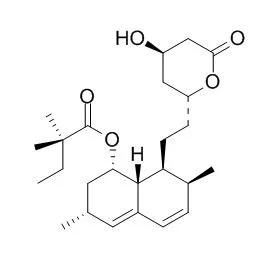| In vivo: |
| J Cereb Blood Flow Metab. 2015 Mar;35(3):512-20. | | Simvastatin restored vascular reactivity, endothelial function and reduced string vessel pathology in a mouse model of cerebrovascular disease.[Pubmed: 25564230] | Cerebrovascular dysfunction seen in Alzheimer's disease (AD) and vascular dementia (VaD) is multifaceted and not limited to the amyloid-β (Aβ) pathology. It encompasses structural alterations in the vessel wall, degenerating capillaries (string vessels), vascular fibrosis and calcification, features recapitulated in transgenic mice that overexpress transforming growth factor-β1 (TGF mice). We recently found that Simvastatin rescued Aβ-mediated cerebrovascular and cognitive deficits in a transgenic mouse model of AD. However, whether Simvastatin can counteract Aβ-independent deficits remains unknown.
METHODS AND RESULTS:
Here, we evaluated the effects of Simvastatin in aged TGF mice on cerebrovascular reactivity and structure, and on cognitive performance. Simvastatin restored baseline levels of nitric oxide (NO), NO-, and KATP channel-mediated dilations and endothelin-1-induced contractions. Simvastatin significantly reduced vasculopathy with arteriogenic remodeling and string vessel pathology in TGF mice. In contrast, Simvastatin did not lessen gliosis, and the cerebrovascular levels of pro-fibrotic proteins and calcification markers remained elevated after treatment. The TGF mice displayed subtle cognitive decline that was not affected by Simvastatin.
CONCLUSIONS:
Our results show potent benefits of Simvastatin on endothelial- and smooth muscle cell-mediated vasomotor responses, endothelial NO synthesis and in preserving capillary integrity. We conclude that Simvastatin could be indicated in the treatment of cerebrovascular dysfunction associated with VaD and AD. | | J Invest Dermatol. 2015 Apr;135(4):1080-8. | | Simvastatin prevents and reverses depigmentation in a mouse model of vitiligo.[Pubmed: 25521459] | Vitiligo is a common autoimmune disease of the skin that results in disfiguring white spots. There are no Food and Drug Administration (FDA)-approved treatments, and current treatments are time-consuming, expensive, and of low efficacy. We sought to identify new treatments for vitiligo, and first considered repurposed medications because of the availability of safety data and expedited regulatory approval. We previously reported that the IFN-γ-induced chemokine CXCL10 is expressed in lesional skin from vitiligo patients, and that it is critical for the progression and maintenance of depigmentation in our mouse model of vitiligo. We hypothesized that targeting IFN-γ signaling might be an effective new treatment strategy. Activation of signal transducer and activator of transcription 1 (STAT1) is required for IFN-γ signaling and recent studies revealed that Simvastatin, an FDA-approved cholesterol-lowering medication, inhibited STAT1 activation in vitro.
METHODS AND RESULTS:
Therefore, we hypothesized that Simvastatin may be an effective treatment for vitiligo. We found that Simvastatin both prevented and reversed depigmentation in our mouse model of vitiligo, and reduced the number of infiltrating autoreactive CD8(+) T cells in the skin. Treatment of melanocyte-specific, CD8(+) T cells in vitro decreased proliferation and IFN-γ production, suggesting additional effects of Simvastatin directly on T cells.
CONCLUSIONS:
Based on these data, Simvastatin may be a safe, targeted treatment option for patients with vitiligo. |
|






 Cell. 2018 Jan 11;172(1-2):249-261.e12. doi: 10.1016/j.cell.2017.12.019.IF=36.216(2019)
Cell. 2018 Jan 11;172(1-2):249-261.e12. doi: 10.1016/j.cell.2017.12.019.IF=36.216(2019) Cell Metab. 2020 Mar 3;31(3):534-548.e5. doi: 10.1016/j.cmet.2020.01.002.IF=22.415(2019)
Cell Metab. 2020 Mar 3;31(3):534-548.e5. doi: 10.1016/j.cmet.2020.01.002.IF=22.415(2019) Mol Cell. 2017 Nov 16;68(4):673-685.e6. doi: 10.1016/j.molcel.2017.10.022.IF=14.548(2019)
Mol Cell. 2017 Nov 16;68(4):673-685.e6. doi: 10.1016/j.molcel.2017.10.022.IF=14.548(2019)